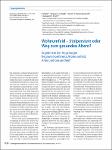Wohnumfeld – Stolperstein oder Weg zum gesunden Altern?
Strobl, Ralf
Maier, Werner
Mielck, Andreas
Fuchs, Judith
Richter-Kornweitz, A.
Gostomzyk, J.
Grill, Eva
Neben einer guten medizinischen Versorgung ist die Struktur des Wohnumfeldes von zentraler Bedeutung, um soziale Teilhabe älterer Menschen zu fördern. Für die Kommunen bedeutet dies, dass sie der altersgerechten Gestaltung des direkten Wohnumfelds hohe Priorität einräumen sollten. Am 1. Oktober 2013 wurden auf der Regionalkonferenz „Wohnumfeld, Alter und Gesundheit“ im Augsburger Rathaus verschiedene Ergebnisse der KORA-Age-Studie zum Thema Teilhabe und Wohnumfeld vorgestellt und mit politischen Entscheidungsträgern aus Augsburg und Seniorenvertretern aus der Region diskutiert. Die Studie untersuchte den Zusammenhang zwischen Wohnumfeld und Teilhabe mittels zweier unterschiedlicher Ansätze: qualitative Ergebnisse aus Fokusgruppendiskussionen und quantitative Ergebnisse basierend auf Telefoninterviews und der Verwendung eines Geoinformationssystems. Die Ergebnisse wurden durch Beiträge aus regionaler und überregionaler Sicht ergänzt. In der Diskussion ergab sich, dass nur mit einem breiten Spektrum an Maßnahmen ein seniorenfreundliches Wohnumfeld geschaffen werden kann, sodass einerseits physische Barrieren abgebaut und andererseits das Gemeinschaftsgefühl, der nachbarschaftliche Zusammenhalt und das Miteinander gefördert werden. In addition to good medical care, living environment is of central importance in encouraging social participation among older people. Therefore, municipalities should prioritise the age-appropriate design of living environments. Results of the KORA Age study were presented at the regional conference “Living environment, age and health” in the Augsburg town hall on October 1, 2013. The results on participation and living environment were discussed with local policy makers and senior citizens’ representatives from Augsburg and two surrounding regions. The study examined the impact of living environment on participation using two different approaches: qualitative findings from focus group discussions and quantitative findings based on telephone interviews and the use of a geographic information system. The results were complemented by contributions from a regional and national perspective. It was stressed in the closing discussion that a senior-friendly living environment can only be created by using a broad range of different measures. On the one hand physical barriers need to be removed, while at the same time the sense of community, neighborhood cohesion and solidarity should be encouraged further.
No license information

